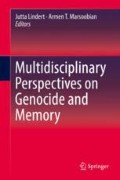Abstract
We often acknowledge and memorialize events of human suffering through works of art. This sometimes begins as a personal statement, as was the case with Picasso’s Guernica . Oftentimes such acknowledgments take the form of a national statement, such as the Memorial to the Murdered Jews of Europe (Denkmal für die ermordeten Juden Europas) in Berlin. The Berlin memorial raises challenging moral and aesthetic questions regarding the memorializing function of such public monuments. What sorts of experiences are such memorials intended to evoke in the viewer? Is there a tension between the aesthetic experience and the “real” emotions such memorials engender? Does the didactic nature of such works rest comfortably with their aesthetic function? Are these functions mutually exclusive? Such questions are addressed in this chapter.
Notes
- 1.
The distinction between “High modernism” and “Modernism” is a tricky one. In the visual arts, some would like to restrict High Modernism to post-World War II art, in particular Abstract Expressionism and all that followed; in literary studies, the term applies to the period between the wars. Arthur C. Danto in chapter 1 of After the end of art (1997) employs Clement Greenberg’s definition of the term “Modernism” in discussing visual art post-Manet and Cézanne.
- 2.
Portions of the film can be viewed at the following website: http://www.pbs.org/wgbh/pages/frontline/shows/germans/
- 3.
A description of the monument can be read on Gerz’s website: www.gerz.fr
- 4.
Information about the museum and its design is available at www.jmberlin.de/site/EN/05-About-The-Museum/03-Libeskind-Building/06-Holocaust-Tower/holocaust-tower.php
- 5.
More pictures of the monument can be viewed on the website of the Armenian Genocide Museum-Institute: www.genocide-museum.am/eng/memorial_complex_photos.php and on the website of the Armenian National Institute: www.armenian-genocide.org/Memorial.28/current_category.52/offset.20/memorials_detail.html
- 6.
Accessed July 7, 2016, at: http://www.genocide-museum.am/eng/Description_and_history.php
- 7.
“As part of the monument, an arrow-shaped stele of granite, 44 meters high, reaches to the sky, symbolizing the survival and spiritual rebirth of the Armenian people. Partly split vertically by a deep crevice, this tower symbolizes the tragic and violent dispersion of the Armenian people, and at the same time, expresses the unity of the Armenian people.” See more at: http://www.genocide-museum.am/eng/Description_and_history.php#sthash.yd7wctec.dpuf
References
Bell, C. (1913). Art. London: Chatto and Windus.
Carroll, N. (2005). Art and recollection. Journal of Aesthetic Education, 39(2, Summer), 1–12.
Danto, A. C. (1997). After the end of art. Princeton: Princeton University Press.
Dewey, J. (1987). Art as experience. In The later works, 1925–1953. Carbondale: Southern Illinois University Press.
Fry, R. (1926). Transformations: Critical and speculative essays on art. London: Chatto and Windus.
Marzynski, M. (2005). A Jew among the Germans (documentary film DVD). Frontline, Public Broadcasting System. http://www.pbs.org/wgbh/pages/frontline/shows/germans/. Accessed June 2016.
Santayana, G. (1924). The life of reason or the phases of human progress: Reason in common sense (2nd ed.). New York: Charles Scribner’s Sons.
Young, J. E. (2000). At memory’s edge: After-images of the holocaust in contemporary art and architecture. New Haven: Yale University Press.
Author information
Authors and Affiliations
Corresponding author
Editor information
Editors and Affiliations
Rights and permissions
Copyright information
© 2018 Springer International Publishing AG
About this chapter
Cite this chapter
Marsoobian, A.T. (2018). How Do We Memorialize Genocide? The Case of the German Memorial to the Murdered Jews of Europe. In: Lindert, J., Marsoobian, A. (eds) Multidisciplinary Perspectives on Genocide and Memory. Springer, Cham. https://doi.org/10.1007/978-3-319-65513-0_10
Download citation
DOI: https://doi.org/10.1007/978-3-319-65513-0_10
Published:
Publisher Name: Springer, Cham
Print ISBN: 978-3-319-65511-6
Online ISBN: 978-3-319-65513-0
eBook Packages: Social SciencesSocial Sciences (R0)

